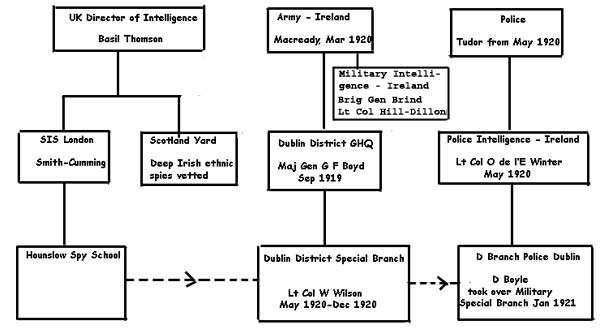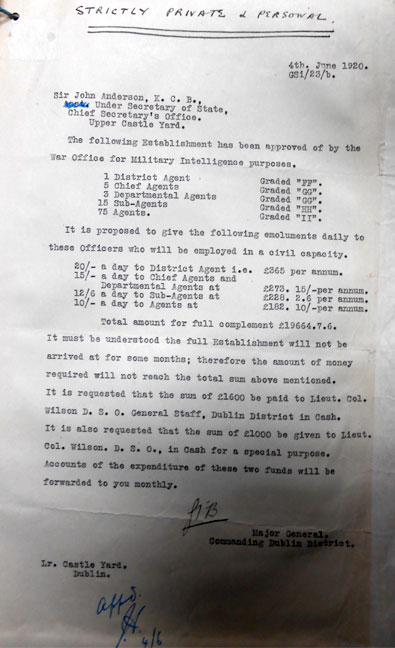

A new British Administration in Dublin in 1920 reorganised both British Intelligence and British Propaganda. Both the British and the Irish had efficient propaganda organisations and were capable and indeed intent on doctoring the news to gain political advantage. And if they could not do that, then at least to minimise the negative effects of news. The British attempted to portray the men murdered as innocent soldiers just doing their duty, and butchered often in front of their wives by the IRA. While the IRA want to put across that they were all dangerous men who would have brought about the death of a great many Irishmen if they had not been silenced, and that further they were killed because specific information existed against each man killed.
It seems that the truth lies between the two opposing lots of spin. The British had trained around 100 specially selected men in London in a unit run by Major C A Cameron, and sent under cover singlely to Ireland. These men were to be infiltrated individually into Irish society, with the aim of breaking the IRA. Collins did draw up a list from his intelligence sources within Dublin Castle for assassinations of some of these agents, but his list was later added to by the local Dublin IRA Brigade.
In May 1920, Lieutenant Colonel Walter Wilson arrived in Dublin to take command of D Branch. Following the events of Bloody Sunday, November 21, 1920, D Branch was transferred to the command of Brigadier-General Sir Ormonde Winter in January 1921. Winter had been placed in charge of a new police intelligence unit, the Combined Intelligence Service, in May 1920, and his charter was to set up a central intelligence clearing house to more effectively collate and coordinate army and police intelligence. The members of D Branch who survived Bloody Sunday were very unhappy to be transferred from army command to CIS command, and, for the next six months, until the Truce of July 1921, D Branch continued to maintain regular contact with Army Intelligence Centre while undertaking missions for Winter's CIS.
The Intelligence group in Dublin worked under Ormonde Winter. Deputy Police Adviser and Head of Intelligence. They included Capt H B C Pollard and Major Cecil Street . The entire Intelligence team lived in quarters at the Royal Marine Hotel at Kingstown but by September 1921 all had for safety moved inside the thick walls of Dublin Castle itself, address being Number 4 Upper Castle Yard. There had been an IRA attack on men in the hotel on 19 Jun 1921
Although the IIS (that is Irish Intelligence) was aware that changes were taking place on the British side, it was some time before it ascertained the identities of the group. Their first break appears to have come following the execution of John Lynch, by the British. After this episode, Lt. Angliss had been one of the killers, and having had a drink too many had divulged his participation in the execution to a girl in his lodgings, who inadvertently passed this information to an IIS informant. Other members of the group were identified by landladies revealing that the men went out late at night. The British undercover men lived in boarding houses and hotels across Dublin, unobtrusively going out to keep tabs on the IRA. While at the same time the IRA Intelligence Department (IRAID) was receiving information from well-placed sources, including Lily Mernin, who was the confidential clerk for British Army Intelligence Centre in Parkgate Street, and Sergeant Jerry Mannix, stationed in Donnybrook. Another IRA source was Constable David Neligan, of G-Division (special branch) of the Dublin Metropolitan Police. Strangely both sides appeared to meet together at the Cafe Cairo, Rabiatti's Saloon and Kidds Back Pub. In addition the IRA, once they knew where undercover men were living could get the Irish servants to report on the mens' movements.
The London Operation to supply agents to Dublin District D Branch
The British Army Intelligence Centre in Ireland recruited a special plainclothes unit originally of 18-20 demobilized ex-army officers and some active-duty officers to conduct clandestine operations against the IRA. The officers received training at a school of instruction in London, most likely under the supervision of Special Branch, which had been part of the Directorate of Home Intelligence since February 1919. They may also have received some training from MI5 officers and ex-officers working for Special Branch. Army Centre, Dublin, hoped these officers could eventually be divided up and deployed to the provinces to support its 5th and 6th Division intelligence staffs, but it decided to keep it in Dublin under the command of the Dublin District Division, General Gerald Boyd, commanding. It was known officially as the Dublin District Special Branch (DDSB) and also as "D Branch".
One by one, they arrived in Ireland, travelling under aliases and using commercial cover, several taking jobs as shop assistants, travelling salesmen or garage hands to avoid suspicion. Professor Bowden believes that the Cairo Group was directed by two men, Peter Ames and George Bennett. These individuals maintained liaison with three veterans of the campaign, Lt. Angliss, alias McMahon, who had returned from Russia to organize intelligence in South Dublin, an Irishman by the name of Peel, and D. L. MacLean, the chief of intelligence at Dublin Castle. There is doubt about Bowden's work, see Townsend's view. I would add that Ames and Bennett were relatively junior in British Intelligence in Dublin, Ames being only a Class II agent, and Bennett a Class HH and area commanders like Carew were Class GG. And the senior Intelligence men in Dublin Castle were Class FF. Besides being more experienced intelligence operatives than those earlier working in Ireland, these men increased the threat to the Irish because they immediately reorganized the British intelligence effort, which until their arrival had been decentralized and uncoordinated. They moved quickly to correct weaknesses. Their accomplishments led ultimately to the events of "Bloody Sunday."
The letter below shows that the British establishment for D Branch
The London Gazette notices lead one to find a number of these men. I have more information on individuals on Castle Intelligence
Grade FF
Grade GG
Grade HH
Grade II

Sir Basil Thomson was Director of Intelligence at the Home Office in London. He appears to have supplied agents with deeper cover. They were not know to Dublin Castle, and , in theory should have been more difficult to find by the IRA than men with records held at Dublin Castle. His agents would have been additional to the Dublin District men above.